Coyote's Run Estate Winery
by
Terry Sullivan
Summary: A laidback, very educational experience awaits visitors to Coyote’s Run Estate Winery. Emphasis is on comparing wines from different soils and years to discover how terroir impacts the wine.
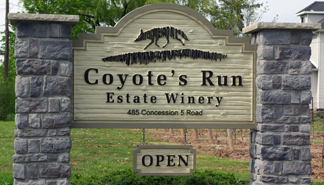 Coyote’s Run Estate Winery opened its doors in 2004. It was a dream come true for Jeff and Patti Aubry who left previous careers to create Coyote’s Run with their partners. We spoke with Patti who was pleased with the move. Although 2003 was the first vintage for Coyote’s Run, the Murdza family who sold grapes to other wineries had grown grapes on the property for over 25 years. The 58 acre vineyard has plantings of Pinot Noir, Chardonnay, Cabernet Sauvignon, Cabernet Franc, Merlot, Syrah, Vidal and Pinot Gris. The name Coyote’s Run was chosen when Jeff and Patti observed coyotes running across the property.
Coyote’s Run Estate Winery opened its doors in 2004. It was a dream come true for Jeff and Patti Aubry who left previous careers to create Coyote’s Run with their partners. We spoke with Patti who was pleased with the move. Although 2003 was the first vintage for Coyote’s Run, the Murdza family who sold grapes to other wineries had grown grapes on the property for over 25 years. The 58 acre vineyard has plantings of Pinot Noir, Chardonnay, Cabernet Sauvignon, Cabernet Franc, Merlot, Syrah, Vidal and Pinot Gris. The name Coyote’s Run was chosen when Jeff and Patti observed coyotes running across the property.
Early vintages proved to be challenging as the weather influenced the quantity of harvested grapes. About 1800 cases were made from the 2004 vintage. The weather has been kinder the last few years and case production is now close to 8,000 cases. The winery can expand to 10,000 cases, however room is beginning to become tight. Two stainless steel tanks had their tops removed and extensions were welded to the bottom pieces to increase the capacity of the tanks.
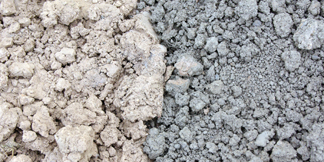 The vineyard lies in the Four Mile Creek sub appellation. The soil in the vineyard is unique; it is made from two types of clay. One is the red clay that you’ll see as you drive between sections of vines to the winery and another is black clay. These two clays produce different wines from the same varietal grapes. The winemaker, David Sheppard, is able to make small batches of wines from grapes grown in the different clays. If the characteristics of the wine are at a level he likes he will make two different wines one from vines grown in red clay and the other grown in black clay. On the other hand, if a blend would be better, David will blend the wines. He uses his talents and over twenty years of winemaking experience to make award-winning wines.
The vineyard lies in the Four Mile Creek sub appellation. The soil in the vineyard is unique; it is made from two types of clay. One is the red clay that you’ll see as you drive between sections of vines to the winery and another is black clay. These two clays produce different wines from the same varietal grapes. The winemaker, David Sheppard, is able to make small batches of wines from grapes grown in the different clays. If the characteristics of the wine are at a level he likes he will make two different wines one from vines grown in red clay and the other grown in black clay. On the other hand, if a blend would be better, David will blend the wines. He uses his talents and over twenty years of winemaking experience to make award-winning wines.
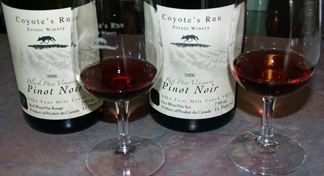 One way of interpreting the meaning of terroir is to think of it as the taste of the geography. Although you can visit several wineries in different locations that have different terroirs, Coyote’s Run Estate Winery affords the opportunity to experience terroir in their tasting room. You can taste two Pinot Noirs, one from vines grown in the red clay soil and the other from vines grown in the black clay soil. You can also taste two different Cabernet Francs. Notice the subtle differences in colors. The bouquets and tastes also differ. We thought wines from the black clay were smooth and calm while wines made from grapes grown in the red clay were feisty. On the day of our visit we had the opportunity to experience the difference in terroir that is weather related by having a vertical tasting of the Cabernet Franc from 2006 and comparing it to the 2007 Cabernet Franc. The weather each of those years was different; 2007 was hot and dry while the weather was much cooler at harvest time in 2006. Check to see if a vertical tasting is available when you visit Coyote's Run.
One way of interpreting the meaning of terroir is to think of it as the taste of the geography. Although you can visit several wineries in different locations that have different terroirs, Coyote’s Run Estate Winery affords the opportunity to experience terroir in their tasting room. You can taste two Pinot Noirs, one from vines grown in the red clay soil and the other from vines grown in the black clay soil. You can also taste two different Cabernet Francs. Notice the subtle differences in colors. The bouquets and tastes also differ. We thought wines from the black clay were smooth and calm while wines made from grapes grown in the red clay were feisty. On the day of our visit we had the opportunity to experience the difference in terroir that is weather related by having a vertical tasting of the Cabernet Franc from 2006 and comparing it to the 2007 Cabernet Franc. The weather each of those years was different; 2007 was hot and dry while the weather was much cooler at harvest time in 2006. Check to see if a vertical tasting is available when you visit Coyote's Run.
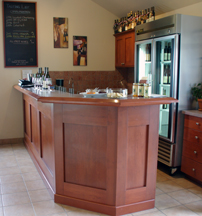 We tasted several wines on the day of our visit. The 2007 Red Paw Vineyard Pinot Gris had a melon bouquet and fruit and spice taste. Although off dry, rated as a 1 for residual sugar, it had a perceived sweetness due to the fruit. The 2007 Unoaked Chardonnay was aged in stainless steel and offered a fruit bouquet and taste with butterscotch on the finish. We compared the Red Paw Vineyard 2006 Pinot Noir with the 2006 Black Paw Vineyard Pinot Noir. Both colors were red; the Red Paw Vineyard had hues of orange in the color and was slightly darker. Both had a red cherry bouquet and taste and earthiness on the finish. The Black Paw Vineyard Pinot Noir was smooth while the Red Paw Vineyard was more acidic. Similarly we compared the Cabernet Francs from the two different clay soils. The Red Paw Vineyard Cabernet Franc had a red brick color while the Black Paw Vineyard had a dark red color. Both had a red fruit nose and taste with soft tannins on the finish. The Black Paw Vineyard Cabernet Franc was smooth while the Red Paw Vineyard Cabernet Franc was crisp.
We tasted several wines on the day of our visit. The 2007 Red Paw Vineyard Pinot Gris had a melon bouquet and fruit and spice taste. Although off dry, rated as a 1 for residual sugar, it had a perceived sweetness due to the fruit. The 2007 Unoaked Chardonnay was aged in stainless steel and offered a fruit bouquet and taste with butterscotch on the finish. We compared the Red Paw Vineyard 2006 Pinot Noir with the 2006 Black Paw Vineyard Pinot Noir. Both colors were red; the Red Paw Vineyard had hues of orange in the color and was slightly darker. Both had a red cherry bouquet and taste and earthiness on the finish. The Black Paw Vineyard Pinot Noir was smooth while the Red Paw Vineyard was more acidic. Similarly we compared the Cabernet Francs from the two different clay soils. The Red Paw Vineyard Cabernet Franc had a red brick color while the Black Paw Vineyard had a dark red color. Both had a red fruit nose and taste with soft tannins on the finish. The Black Paw Vineyard Cabernet Franc was smooth while the Red Paw Vineyard Cabernet Franc was crisp.
We compared the 2006 Cabernet Francs to the 2007 Cabernet Francs from the two vineyards to see the differences that weather can make on wines. Color differences were noticeable. The 2007 Cabernet Francs were darker and purple compared to the red from 2006. The 2007 Red Paw Cabernet Franc had a red stone fruit bouquet and taste and a crisp soft tannin finish. The Black Paw Vineyard 2007 Cabernet Franc had a licorice and spice nose quite different from the 2006. It had red fruit taste, was smooth and had soft tannins on the finish.
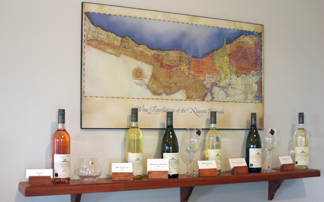 You can experience a delightful time in the tasting room when visiting Coyote’s Run Estate Winery. You will experience the effect that different soil and weather from different years has on wine. Stroll through the tasting room and notice the gourmet vinegars and wine accessories.
You can experience a delightful time in the tasting room when visiting Coyote’s Run Estate Winery. You will experience the effect that different soil and weather from different years has on wine. Stroll through the tasting room and notice the gourmet vinegars and wine accessories.
Coyote’s Run Estate Winery
485 Concession 5
Niagara-On-The-Lake, Ontario, Canada
GPS N 43° 16.971' W 079° 11.902'
Visit this Winery/vineyard travel agency and Canada winery that partner with Wine Trail Traveler.
 |
||
| In Vino Veritas Travel Agency |
